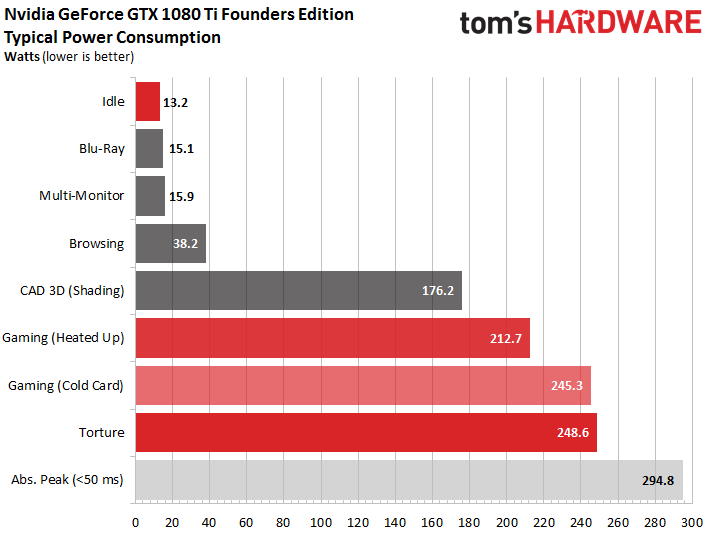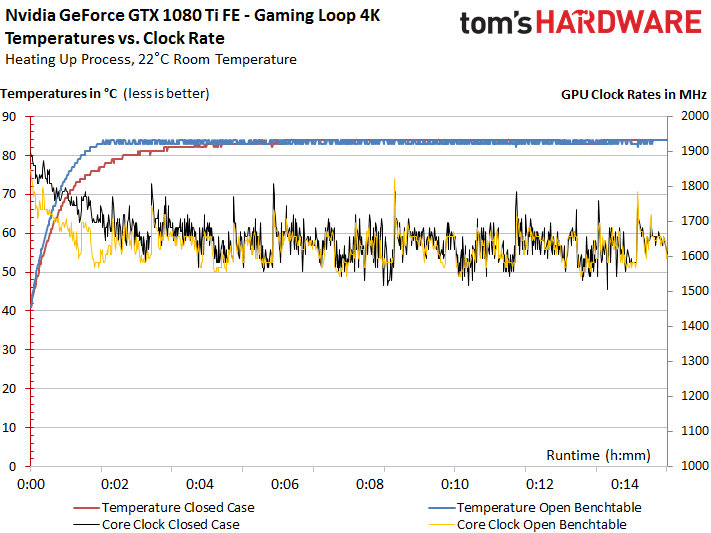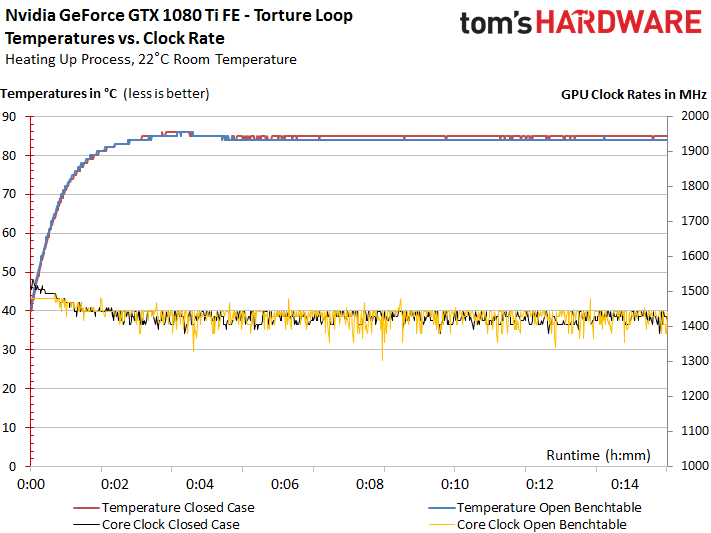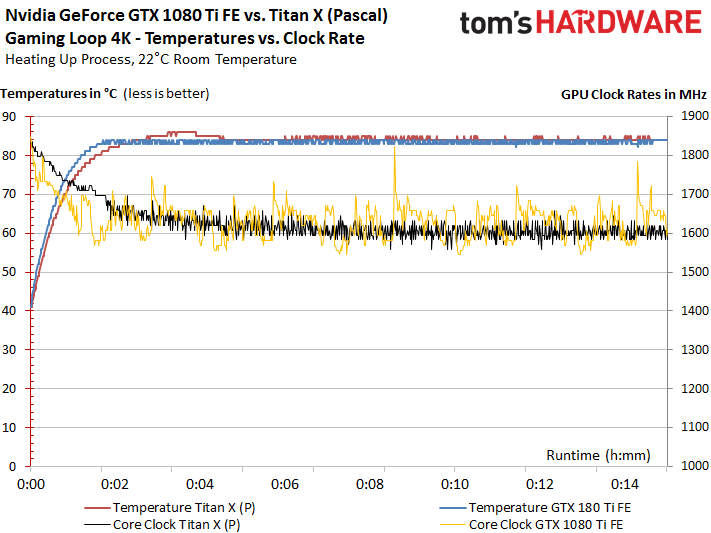Nvidia GeForce GTX 1080 Ti 11GB Review
Nvidia's GeForce GTX 1080 Ti is now the fastest graphics card available, and at $500 cheaper than the previous champ! Should you buy now, or wait for AMD's Vega?
Why you can trust Tom's Hardware
Power Consumption
Our graphics card test setup and methodology are detailed in How We Test Graphics Cards.
At idle, the GeForce GTX 1080 Ti Founders Edition’s power consumption lands exactly where we'd expect: right around 13W.
One result that really stands out is the >30W difference in our gaming workload between the cold and fully-exercised card. We see power drop a bunch once the 1080 Ti reaches its full operating temperature, which means it's hitting a thermal limit and being slowed down by GPU Boost.
To back our claim, we recorded the temperature and clock rate during warm-up and plotted them in the same graph:
Our stress test yields the same drop in frequency, though it's less pronounced due to the much higher load.
How do these results compare to Nvidia's Titan X (Pascal)? A look at our library of data yields some interesting findings.
The GeForce GTX 1080 Ti's average clock rate is a tad higher than the Titan X's once both cards reach their peak operating temperature. However, the 1080 Ti gets there faster, giving the Titan X a boost early on.
Get Tom's Hardware's best news and in-depth reviews, straight to your inbox.
Also interesting is that the Titan X's curve is a lot smoother than the 1080 Ti's, which behaves somewhat frenetically.
The power consumption curves as graphs are provided below, and we start by comparing the cold and warmed-up cards:
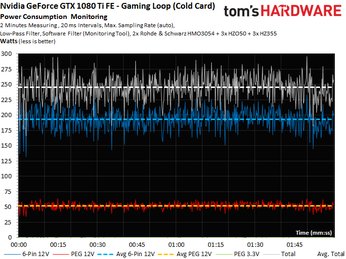
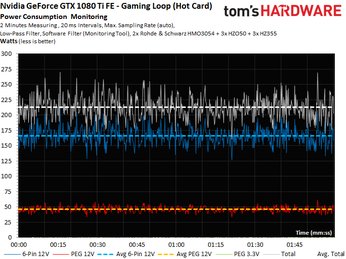
Notice the same large difference in power consumption between the cards' temperature levels.
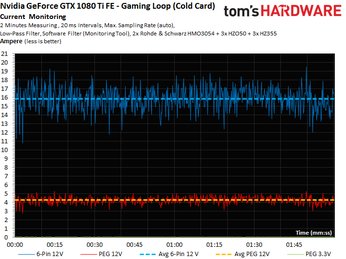
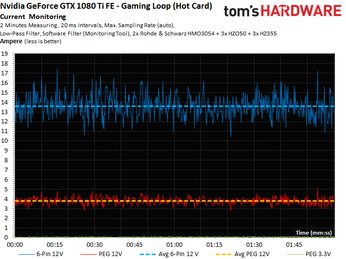
We documented the GeForce GTX 1080 Ti's power consumption and current exclusively at its operating temperature because the two maximum values ended up being almost identical. This is due to the power target of 250W imposing a hard limit, which Nvidia manages to hit very well.
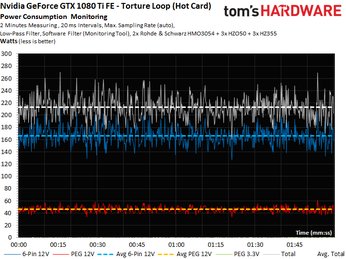
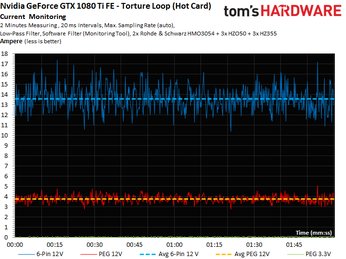
Adherence To Specifications
Ever since the launch of AMD's Radeon RX 480, we look closely at every new card's adherence to the PCI-SIG’s specifications. Nvidia's GeForce 1080 Ti Founders Edition is no exception, and it passes our test with flying colors. It doesn't use the 3.3V rail at all; only the 12V rail.
Our readings put the motherboard slot's 12V rail at approximately 4.4A. Given a ceiling of 5.5A, the card has plenty of room to spare.
-
dstarr3 Oh my. I've got a 980 Ti now, and I thought I could hold out until Christmas 2018 or so to upgrade, but seeing that this card has nearly double the FPS... That's a pretty big deal...Reply -
HaB1971 Would love one, but pointless for 1080p gaming which is what I am restricted to thanks to 2 x 27inch 1080p monitors. I don't need to replace those either they work, they are good enough and not interested in VR etc. 4k for me, is still too priceyReply -
salgado18 Reply19401792 said:Oh my. I've got a 980 Ti now, and I thought I could hold out until Christmas 2018 or so to upgrade, but seeing that this card has nearly double the FPS... That's a pretty big deal...
Why not wait? Your card is still great, and you can pick up a 2080 or Vega 2 by then. Unless you can't live without 4K at Ultra, keep your card. -
Ray_58 Hab1971, 4k really isn't that bad price wise, its ok, part of the problem is the LCD panel industry milking the crap out of 1080p resolutions still up to the 300$ pricepoint when in actuality we should have been at base standard 2k TN/IPS panels at the 160$-300$ range. Still today though the greatest costs are the fact 60htz is still standard and any increase is massive price cost increases, and obviously Gsync for NVidia. Still spending $500-$800 on a monitor and then dropping 700$ on this is a bit 2 much for the mainstream. Id rather buy a 2k IPS screen with Gsync at 700$ than a 4k 60htz monitor at 400$Reply -
envy14tpe Reply19401792 said:Oh my. I've got a 980 Ti now, and I thought I could hold out until Christmas 2018 or so to upgrade, but seeing that this card has nearly double the FPS... That's a pretty big deal...
I feel the same. I see the jump in BF1 to be massive and enough to warrant a 1080 Ti for 1440p gaming. I'm holding out until June when the next Nvidia price drops. -
dstarr3 Reply19401838 said:19401792 said:Oh my. I've got a 980 Ti now, and I thought I could hold out until Christmas 2018 or so to upgrade, but seeing that this card has nearly double the FPS... That's a pretty big deal...
Why not wait? Your card is still great, and you can pick up a 2080 or Vega 2 by then. Unless you can't live without 4K at Ultra, keep your card.
Well, two reasons: 1) I'd like to upgrade to 1440p/144 this year. 2) I also have an HTPC with a 770 in it that needs an upgrade. I was considering buying a 1060 for that computer, but instead, I might just buy this 1080 Ti for my main rig and put its 980 Ti in the HTPC.
Either way, no purchasing until Christmas, because I hate paying full price for just about anything. So I've got time to think about this.
